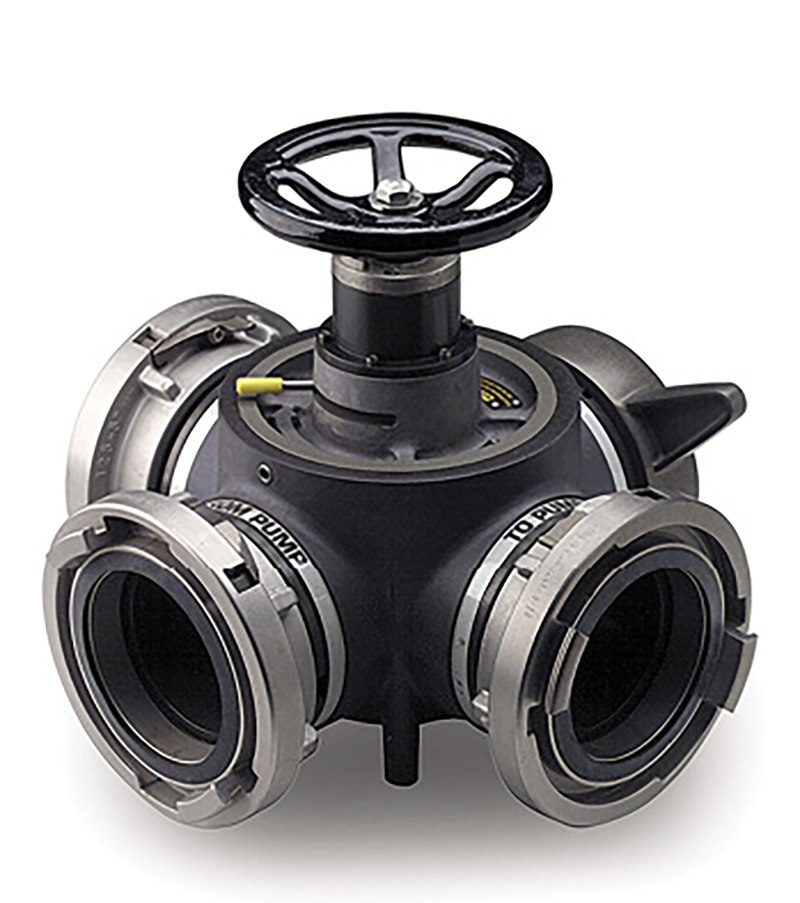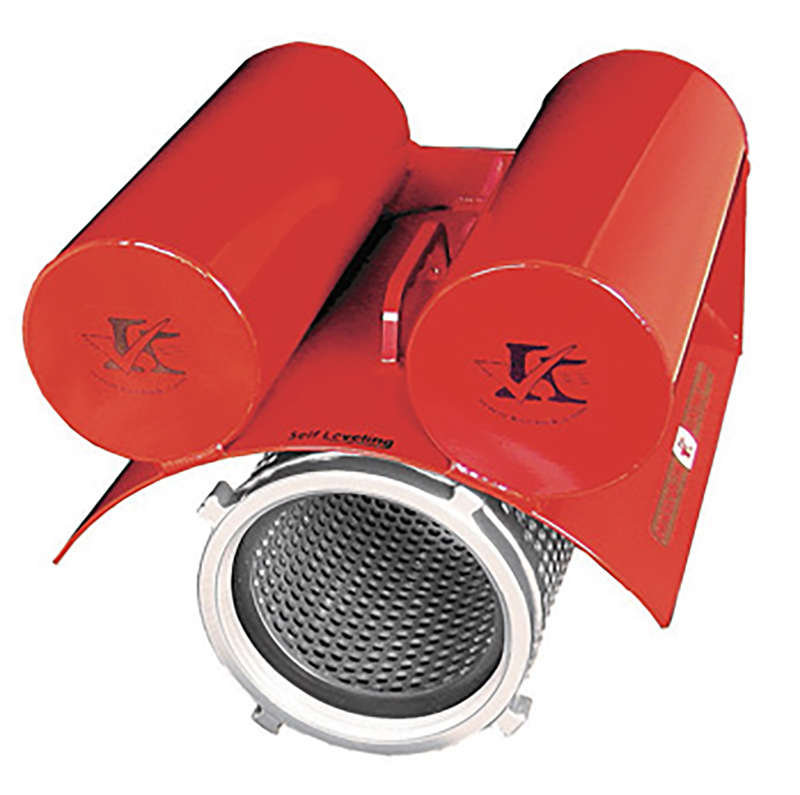It has been said that hoselines are a firefighter’s lifeline, so getting the water into those hoselines is of the utmost importance. And, the way fire departments do that is through pressurized hydrants; dry hydrants; or drafting from static sources like ponds, rivers, and portable water tanks.
Hydrant Valves
Task Force Tips manufactures a highly flexible Oasis valve that is great for both hydrant boosting and inline relay operations, according to Phil Gerace, TFT’s vice president of marketing. “The Oasis operates in two modes,” Gerace says. “Mode One lets you operate off a hydrant or any pressurized source to move water directly from the hydrant to your attack engine at the fire scene. Mode Two allows for a second engine to connect to the valve and boost the pressure at the hydrant, allowing for higher residual intake pressure at the attack engine. The design of the Oasis also makes it ideal for inline relay pumping applications.”

1 Task Force Tips makes the Oasis valve that can be used for both hydrant boosting and inline relay operations. (Photo 1 courtesy of Task Force Tips.)
Jason Riggenbach, product manager for Akron Brass Company, a division of IDEX Corporation, says that Akron Brass makes its 4-Way Hydrant Valve that allows a department to provide water to the fire at hydrant pressure while waiting for a second pumper to hook up and increase flow and pressure. Riggenbach says the way the valve works is that the 4-Way Hydrant Valve is attached to the hydrant, and the pumper forward lays to the fire scene. Back at the hydrant, a second engine attaches a hose from the hydrant valve to the engine’s intake, then attaches a hose from a discharge to the hydrant valve inlet, which establishes recirculating water flow at hydrant pressure. The hand wheel on top of the hydrant valve is then rotated to introduce pressurized flow from the engine at the hydrant to the engine at the fire scene. Pressure on the hydrant pumper is increased as more flow is required.
Riggenbach notes that Akron Brass also makes 2½-inch hydrant valves with a Tork-Lok handle for positive handle positioning in both an aluminum gate valve screw handle model and a quarter-turn ball valve version. Both models operate to 250 pounds per square inch (psi). Akron Brass’s Revolution 7982 intake valve with an elbow is often used for hydrant work, while the 7983 intake valve is used for drafting and has a 12-inch hand wheel, he adds.

2 Akron Brass Company makes the 4-Way Hydrant Valve that allows a seamless transition from hydrant pressure to engine-boosted pressure over a supply line. (Photo 2 courtesy of IDEX Corp.)
IDEX also offers a Hale Products master intake valve (MIV), a six-inch valve positioned behind the panel on the intake side of the pump that allows for prepriming ability when drafting and running lines so there is no air gap or down time when transitioning from tank suction to draft, Riggenbach says.
Paul Carpenter, vice president of sales for Harrington Inc., points out that Harrington makes adapters and various valves for hydrants, as well as drafting equipment to get water from any type of water source into hoselines. “We make the H700 Hydrassist LDH Hydrant Valves that are excellent for boosting pressure on long hoselays or for boosting low hydrant pressure,” Carpenter points out. “Our lightweight hydrant valves enable the first-in pumper to lay large-diameter hose (LDH) directly from the hydrant to the fire, and when the hoselay is completed, start flowing water from the hydrant. If additional pressure is required, another pumper can connect to the Hydrassist valve and start pumping to raise pressure and flow without interrupting the established water supply.”

3 Harrington Inc. makes the H700 Hydrassist LDH Hydrant Valve that allows for boosting pressure on long hoselays or boosting low hydrant pressure. (Photo 3 courtesy of Harrington Inc.)
Harrington also makes the HJ20 valve, which Carpenter says is a popular one with rural fire departments. “If you have a house set back 300 or 400 feet on a country lane, you have one pumper at the house with a hoselay back to another pumper with an HJ20 valve that allows two hoses to connect to a Siamese to merge water into a single supply line,” he says. The company also makes a line of hydrant adapters that convert various threads to Storz fittings.
Drafting
Marco Decenzi, vice president of sales and marketing for Kochek Inc., says his company’s intent is to provide products to move fluid from its source to wherever it’s needed to fight fire, typically from pressurized hydrants and natural and static water sources. “We make hydrant converters that change the hydrant threads to Storz connections,” Decenzi points out, “which makes it easier to connect the hose with only a quarter turn. In addition, we make spanners and wrenches to deal with the hydrant caps and shutoffs.”
Kochek makes a variety of valves to control and distribute water flow to one or multiple hoses, observes Jon Riel, Kochek’s senior mechanical designer. “For hydrants, our most popular is our gate valve that we offer in three styles,” Kiel notes, “in straight, elbow, and elbow with pressure relief models. They are used for 3-inch through 6-inch connections, and the most popular is a medium-size 4-inch valve body gate valve with a hand wheel on top.”

4 Kochek makes a self-leveling floating strainer for use in drafting operations. (Photo 4 courtesy of Kochek Inc.)
In terms of drafting equipment, Carpenter notes that Harrington makes suction hose up to 20 feet long, from 1½-inch diameter to 6-inch diameter, as well as an assortment of barrel, floating, basket, and low-level strainers. He notes the low-level strainer models have a jet siphon feature. Harrington also makes 5-inch flangeless butterfly valves for tanker dumps that are either lever or gear operated for slow open/close operation.
Kiel says that Kochek makes the parts to put together a dry hydrant that is connected to a water source so it’s ready to be used when needed in places where the pumper can’t get close to the static water source. “We also make a variety of strainers for the end of drafting hose,” he says. “One of the most popular models is a self-leveling floating strainer that always ends up vertical and keeps the hose off the bottom of the water source. We also have a barrel strainer that’s easy to deploy if you’re not dealing with silt or vegetation on the bottom, an ice strainer with a clamp for drawing water from a frozen pond, and a low-level strainer for drafting out of shallow water sources, ponds and portable water tanks.”
ALAN M. PETRILLO is a Tucson, Arizona-based journalist, the author of three novels and five nonfiction books, and a member of the Fire Apparatus & Emergency Equipment Editorial Advisory Board. He served 22 years with the Verdoy (NY) Fire Department, including in the position of chief.

